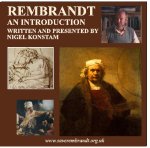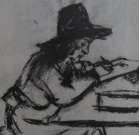23:00 - 11.07.2007
Follow this Fast Track Introduction to gain a quick overview of the controversy surrounding Rembrandt scholarship. Or use the menu on the left for exploring the ideas in greater depth
The Story of a Discovery
Written by Nigel Konstam
Edited by Nancy Grossman-Telfer
Recently Rembrandt scholars have reduced the number of drawings and paintings that they accept as being by Rembrandt by between 50% and 70%. A massive change of opinion from scholars in the past. Why has this happened and where does the truth lie? I have studied this problem for over 35 years. I have come to the conclusion that we are dismissing works that are truly by Rembrandt because of a misunderstanding of his character as an artist.
Read More >
VIDEOS:
PART I: Crude Fake attributed to Rembrandt (2 Minutes)
PART II: Genuine brilliant Rembrandt attributed to a Dull Student (2 minutes)
Adoration of the Shepherds YouTube video
YouTube video challenging Sir Nicholas Serota's directorship of the Tate Gallery
The Blindness of the Experts: Rembrandt and Bol



This Six Chapter DVD Nigel Konstam reveals Rembrandt's working methods, creative process, interests and values. Nigel takes a critical look at how the Great Master has been reinvented by modern art scholars.
- INTRODUCTION - In which we see how scholars' expectations of genius lead to the loss of great works of art. Looking at style rather than human content misleads. -INTRODUCTION -THE DEATHBED OF DAVID -THE VIRGIN AND CHILD
- EXPERIMENT AND CHANGE -JOB -REMBRANDT THE DIRECTOR
- IMAGINATION - Shows how what we admire in Rembrandt's work is observed from life, and what leads scholars to disqualify is made up -ISAAC AND ESAU -REMBRANDT MISUNDERSTOOD -THE LION HUNT
- MIRRORS - The use of mirrors proves that Rembrandt did indeed draw from life and challenges present methods of dating works of art. -MUSICIANS, -MUMMERS, -TWO DRAWINGS (Woman in North Holland Dress) -MANY DRAWINGS (Hagar series) -CONCLUSIONS
- CHRIST RAISING A SICK WOMAN Rembrandt's interests and working method
- THE UNWORTHY WEDDING GUEST Rembrandt shows us the inner thougts of his characters and his own creative process
New for 2010 The Adoration of the Shepherds - Nigel Compares two oil paintings by Rembrandt - one of which has been de-attributed and demonstrates that one is a mirror image of the other. Nigel would like to make a TV documentary to make the position of Rembrandt scholarship better known. His DVD is available now free of charge to anyone interested in making the documentary. (Running time about 1 hour total). The DVD takes the arguments presented here much further. Nigel Konstam, the author and discoverer of the above is available for consultation or participation in the project.
LINKS: Rembrandt , Nigel Konstam , mirrors , modern criticism , Adoration , THE DEATHBED OF DAVID , THE VIRGIN AND CHILD ,JOB AND HIS COMFORTERS , ISAAC AND ESAU MUMMERS Hagar series THE UNWORTHY WEDDING GUEST , David anoints Solomon , Museum of Artist's Secrets , Nancy Grossman-Telfer
Read more...
09:53 - 12.10.2007
Click here to watch 5 minute video on the Adoration
National Gallery Rejects The Adoration

There are two versions of The Adoration of the Shepherds, one in Munich and the second in the National Gallery (London). Both were once attributed to Rembrandt: The Munich version is still a Rembrandt. The London version has been de-attributed by the Rembrandt Research Project (RRP) in spite of the fact that the National Gallery experts examination of the materials confirmed that the painting was from Rembrandt's studio. The object of this demonstration is to prove that the London painting is truly a Rembrandt though the RRP insists that this version cannot possibly be by him.
On the right of the photograph you see a maquette made from the figures and architecture in the Munich painting, that Rembrandt observed and painted direct from life. A cow and a basket also form a part of the composition.
The reflected part of the photograph you see in the mirror (on the left) matches up with the subject matter of the London painting to such a degree that we cannot doubt that Rembrandt (or whoever else was painting from Rembrandt's precise position) painted what he saw in the mirror. As the use of a mirror can be demonstrated many times in Rembrandt's accepted drawings it is most rational to assume that Rembrandt stayed in the same position and painted both paintings; probably concurrently, with the same palette and brushes.
It is amusing to note that while the humans are static, only the cow moved: the hats of the figures remain the same, the basket on the post is seen in elevation in the Munich version and in plan in the London version, the lantern is still carried by the man with the broad brimmed hat, lots of tiny details are transmuted but most of all the infinitely complex space relationship between the figures remains constant.
By understanding the extreme complexity of the task of constructing the London subject from the Munich painting, we can be certain that a mirror was used.(This is no simple print image. It is a reversal of a new point of view of the same very complex, three dimensional group we see in the Munich painting.) From this understanding we not only regain a lost Rembrandt, we demonstrate that the impressionistic style of the London painting is also Rembrandt's. Thus widening the stylistic spectrum that has been imposed arbitarily by the RRP.
Furthermore it is proved that Rembrandt worked from a theatrical-type production. I believe he set up live models dressed with costumes (mentioned in his inventory of 1656) in the adoration paintings, I believe the scene was staged in a barn. These tableaux-vivants, the very life's blood of Rembrandt's work as artist and teacher, are implicitly denied by the RRP and their followers, who are keepers of Rembrandt drawings in the museums: a fundamental error, which invalidates many of the experts' judgements over the last 100 years.
*************** Two legitimate questions may arise from this demonstration 1. did mirrors of this size exist in Rembrandt's time? Answer � not made from one sheet of glass � this large mirror was probably made of polished metal. And 2. Why should he work from an inadequate reflection of his models when he had a group to observe direct from life? Answer � Rembrandt was not alone in the barn. There are student versions of this same scene, both drawn and painted, that show that students were working side by side with the master, each with their own individual viewpoint. This would have inhibited Rembrandt's freedom to move himself or change the group of models. Alternatively, it may just be Rembrandt's explorative spirit that drove him to this single experiment, which he never repeated in painting, but many times while drawing.
*************** If you have doubts please look at the rest of this website before submitting your questions.
It is my belief that the other end of the spectrum of style in Rembrandt's paintings should also be redefined by testing a painting in The Wallace Collection: The Uncharitable Servant. This painting was once the most highly valued Rembrandt in the world. It has been described as Rembrandt at the extreme limits of his ability, it is not typical of Rembrandt but Rembrandt is a most varied artist and we need to define the outer limits of his variability as precisely as possible. If The Uncharitable Servant, was put through autoradiographic tests this would show us the way the painting had been built up right from the original drawing on canvas, thus establishing a clear attribution. The result of this could be to re-inflate Rembrandt's oeuvres and reputation back to where they both stood 50 years ago. If the London painting turns out not to be a Rembrandt the case for widening the spectrum towards a loose impressionistic style remains imperative.
Read more...










